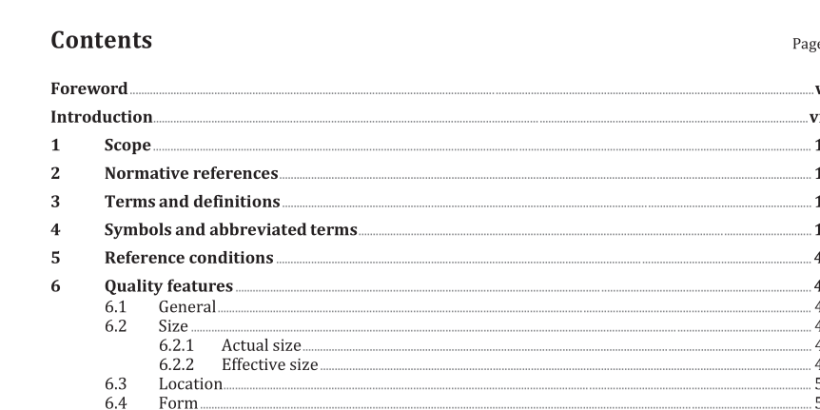ISO 4156-3:2021 pdf download – Straight cylindrical involute splines — Metric module, side fit — Part 3: Inspection.
5 Reference conditions The standard reference temperature for industrial length measurements is 20 °C. The dimensional requirements for parts and gauges are defined at that temperature and inspection shall also normally be carried out at that same temperature. If measurements are taken at another temperature, the results shall be corrected using the expansion coefficients of parts and gauges respectively. Unless otherwise specified, all measurements shall be made under zero measuring load. If measurements are made under a non-zero load, the results shall be corrected accordingly. However, such correction is not required for comparison measurements made with the same comparison means and under the same measuring load, between similar components of the same material and with the same surface condition. 6 Quality features 6.1 General The inspection of splines is divided into three quality features, as shown in Figure 1. To specify the location ISO 1101 and ISO 5459 shall be used. For form and size ISO 4156-1 and ISO 4156-2 apply.
6.3 Location The location of a spline is the location of the central axis in relation to any other geometrical element found by actual or effective inspection methods. 6.4 Form The form deviations of a spline are the deviations to the true geometrical form of profile, helix and pitch. 7 Methods of inspection 7.1 Size 7.1.1 General methods Three general methods of inspection are provided in Table 1. If not otherwise specified, the standard method shall be used. If the alternative methods A or B are required, this shall be stated in the part data table. For the consequence of general methods, see Table 2.
7.1.3.3 NO GO sector gauge The NO GO sector gauge is used to inspect the specified actual tolerance limit of the circular tooth thickness or space width at the minimum material condition of the part, where the gauge contacts only at the ends. 7.1.3.4 Span size over k teeth The span measurement facilitates the calculation of the theoretical actual circular tooth thickness of external splines at the pitch circle diameter based on the measurement over a block of teeth. Before using this method, suitability should be checked.
7.1.3.5 Variable sector gauge The variable sector gauge measures the actual circular tooth thickness or space width. The actual measurement is achieved using radially locking left- and right-hand flanks and comparison to a master having a known tooth thickness or space width. 7.1.4 Effective size 7.1.4.1 GO composite gauge GO composite gauges are used to check a) that the specified effective limits of tooth thickness or space width are not exceeded at the maximum material condition of the part, b) the specified form diameter of the part, thus ensuring that the required tolerances are controlled for the full involute depth, and c) the specified length of engagement, thus ensuring that the spline maximum material limit has not been exceeded. 7.1.4.2 Variable composite gauge The variable composite gauge measures the effective size of tooth thickness or space width. The actual measurement is achieved using the radially locking left- and right-hand flanks and comparison to a master having a known tooth thickness or space width. 7.1.4.3 NO GO composite gauge The NO GO composite gauge is used to check the specified effective limit of minimum tooth thickness or maximum space width, where the gauge contacts only at the ends.
7.1.4.4 Inspection of diameter at tooth tip (D ii or D ee ) All these inspection methods require measuring the tooth tip (internal minor diameter, D ii , or external major diameter, D ee ) using GO and NO GO plain (plug or ring) gauges or other acceptable measuring devices. 7.2 Location 7.2.1 General Splines have an actual and effective true size of space width or tooth thickness, and hence also an actual and effective axis. The tolerances concerning location (i.e. runout, total runout, concentricity, and coaxiality tolerances) shall be specified on the component drawing. Where the spline is used as a datum axis, other geometry features shall be toleranced to the spline axis. Because of the inherent form deviations, difficulties arise in the reproducibility and repeatability of the spline profile if the form deviations and cylindricity deviations are numerous. 7.2.2 Choice of the method of inspection of location The methods of inspection of location are given in Table 4.
